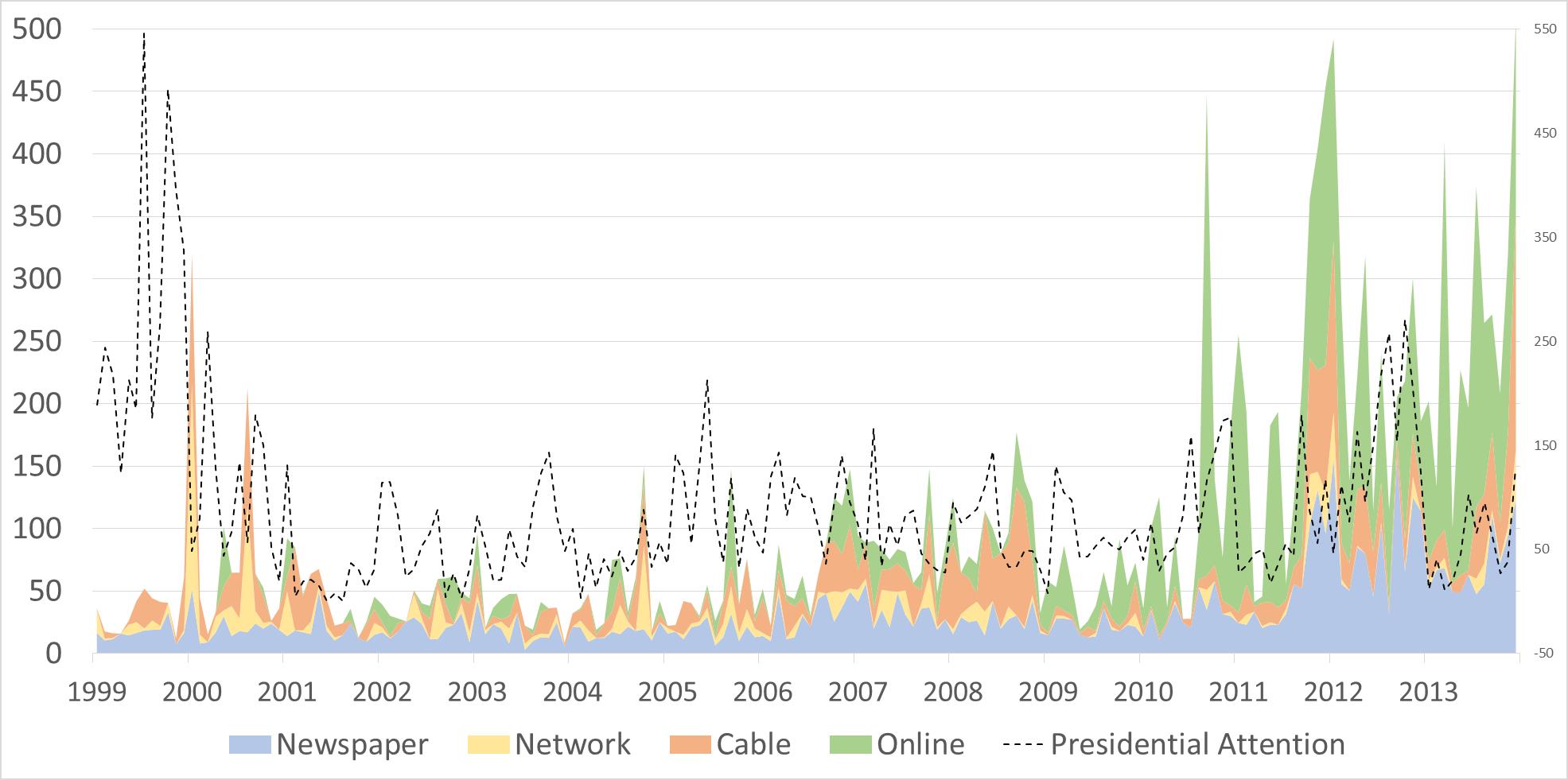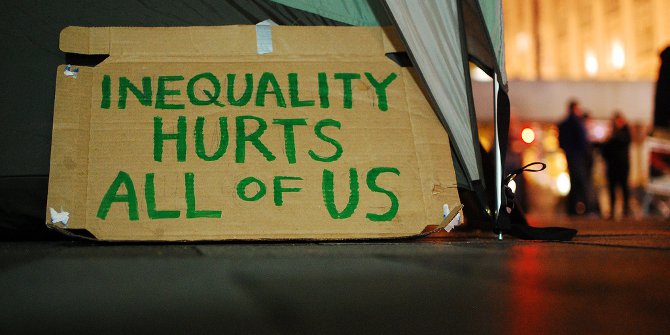
 The election of Donald Trump has reaffirmed that presidents are still able to lead the news agenda in the US. But, can presidents use this power to lead debates towards legislative fixes in important policy areas? In new research that examines 14 years of presidential news coverage, Matthew Eshbaugh-Soha and Ronald J. McGauvran find that presidential attention appears to have led news coverage of inequality, a pattern that is especially true of Democratic presidents. Despite this relationship, they write, presidents often do not respond further to the increased news attention, meaning that federal policy responses are unlikely.
The election of Donald Trump has reaffirmed that presidents are still able to lead the news agenda in the US. But, can presidents use this power to lead debates towards legislative fixes in important policy areas? In new research that examines 14 years of presidential news coverage, Matthew Eshbaugh-Soha and Ronald J. McGauvran find that presidential attention appears to have led news coverage of inequality, a pattern that is especially true of Democratic presidents. Despite this relationship, they write, presidents often do not respond further to the increased news attention, meaning that federal policy responses are unlikely.
Of any single American, the president is in the best position to lead the news agenda. This is changing, though; technological advancements and the increasing variety of news options have created an unpredictable news environment that is eroding the president’s place as the top agenda-setter in US politics. In new research, we argue that presidents, particularly Democratic presidents, can lead most news coverage of income inequality, although their power insufficient to produce major legislative changes.
If presidents hope to generate lasting policy change on important issues, affecting news coverage is the first step in doing so. As Americans enjoy more news and entertainment choices, however, presidents are no longer guaranteed access to the large viewing audiences they once had. To be sure, the increased diversity of available media choices supplies presidents with more options when communicating their policy agendas. They are no longer restricted to three broadcast networks and national newspapers, a characteristic of the broadcast era. Even so, fragmented media incentivizes the public to ignore presidential politics, which may simultaneously undermine the president’s ability to lead all news coverage, and thus those issues the nation deems important, through their public rhetoric.
On many important issues, leading news coverage is often a precursor to forcing legislative action (depending on whether the president’s party controls Congress, of course.) One important issue that has been at the forefront of the public’s consciousness since the global financial crisis of 2008 is income inequality. It has dominated our politics for the last decade, and was an important part of the 2016 presidential race. Although some research suggests that Republican economic policies have compounded inequality, none of this research underscores the importance of media coverage to the prospects for policy change or the role presidents play in encouraging news to cover the topic. Although our research stops short of answering whether presidents who prioritize the issue and lead news coverage also affect income inequality through policymaking, we do show that presidents who speak about income inequality influence the national policy debate.
To see whether presidents have influenced news coverage in an increasingly diverse news environment, we code weekly news coverage from 1999 through 2013 for newspapers (New York Times and Washington Post), broadcast (NBC and CBS) and cable television news (CNN, Fox News Channel (FNC), and MSNBC) transcripts, and political websites (slate.com and nationalreview.com). The figures included document some important variation by news media, which also tell an important story of the ebb and flow of news coverage of this important issue: News coverage fluctuates predictably according to events that drive much news coverage.
“DSC_8882” by Dean Chahim is licensed under CC BY NC SA 2.0
The importance of income inequality has varied by presidential administration. In the late 1990s, Bill Clinton heightened attention to the issue by arguing that the economic boom of the late 1990s should extend beyond a few, who benefited greatly, to an even broader segment of American society. Not unlike other policy issues, income inequality fell off the national agenda when President Bush turned his attention elsewhere, only to rise again during the 2004 presidential election and the accompanying economic slowdown. Bush had to respond to John Kerry’s charge that the Bush tax cuts hurt lower and middle class Americans. Although this criticism did not cost him reelection, it did reinforce the conventional wisdom the income inequality worsens under Republican Administrations. Naturally, attention to income inequality rose again after the 2008 financial meltdown and the Great Recession that followed. Without a consensus on how to address the issue at the federal level, the first year of the Obama Administration witnessed the rise of the Tea Party and Occupy Wall Street movements, each of which spoke to the larger issue of income inequality with the latter generating a spike in news coverage of the issue (see Figure 1).
Figure 1 – Weekly Attention to Income Inequality, by Type of News Source

Sources: coded from transcripts retrieved from Lexis-Nexis Academic, Public Papers of the Presidents, and from online websites.
The president’s attention (collected from weekly mentions of income inequality in the Public Papers of the Presidents) not only correlates with this news coverage, but also appears to have led it. Indeed, the impact of presidential attention on news coverage is quite large, as presidential attention to income inequality has led to an increase of news coverage of it across most news sources except surprisingly for broadcast television news. This is compelling evidence in favor of presidential leadership of the news even within the fragmented media environment of the post-broadcast age. The reverse does not hold, however; news coverage of income inequality fails to influence presidential attention to it. Finally, we find that Democratic (not Republican) presidents are the primary leaders of coverage of income inequality just as the Occupy Wall Street movement caused a spike in coverage of the issue.
Our findings have two important implications. First, they support the partisan nature of income inequality: Democrats prefer to prioritize income inequality and are more likely to use their public rhetoric as a vehicle to focus national attention on it. Second, the lack of a reciprocal relationship between the president and news media suggests one reason for why significant policy change on income inequality has been lacking at the federal level. If media attention to an issue increases in response to presidential speeches about it or events related to it (e.g., Occupy Wall Street), but presidents do not respond further to this increased news attention in their public speeches (and, eventually, as part of their legislative agendas), then a major federal policy response may be unlikely. After all, policy change is most likely when the news media, presidents, and other federal institutions share the same priorities.
In the absence of the clear and consistent convergence of presidential and news priorities, policy change is unlikely but not impossible. There are myriad avenues to the legislative agenda, after all, whether by policy entrepreneurs or through institutional responses to crises or other events that may transcend predictable and partisan voting patterns. Given our findings, it is likely that significant policy changes on income inequality are likely to come from somewhere other than the White House.
- This article is based on the paper, ‘Presidential Leadership, the News Media, and Income Inequality’, in Political Research Quarterly.
Please read our comments policy before commenting.
Note: This article gives the views of the author, and not the position of USAPP – American Politics and Policy, nor of the London School of Economics.
Shortened URL for this post: http://bit.ly/2iv0RLY
_________________________________________
About the authors
 Matthew Eshbaugh-Soha – University of North Texas
Matthew Eshbaugh-Soha – University of North Texas
Matthew Eshbaugh-Soha, is Department Chair and Professor of Political Science at the University of North Texas His research focuses on American political institutions, specifically the presidency and mass media, and public policy. He is the author of nearly three dozen scholarly articles and two books, the most recent of which is Breaking through the Noise: Presidential Leadership, Public Opinion, and the News Media (Stanford University Press).
 Ronald J. McGauvran – University of North Texas
Ronald J. McGauvran – University of North Texas
Ronald J. McGauvran is a PhD Candidate at the University of North Texas, with research interests in economic inequality and political behavior. His dissertation, The Middle Matters: Political Responses to Income Inequality in an American State, examines the participatory effects of income inequality at the community level.




